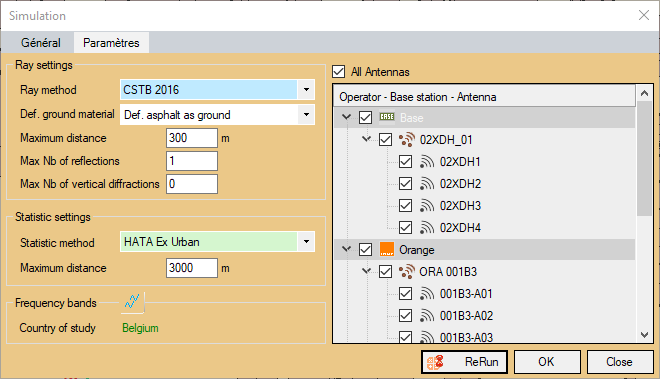|
<< Click to display Table of content >> Simulation parameters |
  
|
|
<< Click to display Table of content >> Simulation parameters |
  
|
The simulation parameters can be found on the Parameters tab in the Simulation window.

Calcul : paramètres
Simulation methods: ray and statistic
MithraREM integrates two main families of simulation methods: on the one hand simulation with a rays approach and on the other hand simulations with a statistical approach.
The simulations based on a ray method precisely determine all the propagation paths between the transmitters and the simulation receivers, taking into account the effects of reflection and diffraction by the obstacles in the environment. In an urban environment, and given the physical assumptions on which they are based, these ray methods are valid for frequencies above 400 MHz. As a result, they are particularly suitable for calculating exposure levels related to mobile telephony antennas (GSM, UMTS, LTE).
The simulations based on a statistical method use heuristic propagation models. These associated models are built from measurement results for different types of environment. A single equivalent propagation path is considered. The influence of environmental obstacles on propagation is taken into account through the parameters of the model. These models can be used for lower frequency ranges, starting at around 30 MHz. They are particularly suitable for calculating exposure levels associated with transmitters in the broadcasting bands.
In MithraREM, each frequency band is associated to a type ray/statistical simulation (read chapter List of frequency bands). During a simulation, calculations are performed using the ray or the statistical method depending on the frequency band of each antenna.
•Ray method
▪The CSTB 2016 method is described in the technical documentation. This is an improvement of the method CSTB 2013 taking better account of the sidelobes.
▪The CSTB 2016 - Indoor method allows indoor simulations without reflection in facade and taking into account the attenuations as a function of the angle of incidence and materials. This corresponds to the estimate of an average exposure level behind the facade of the buildings, obtained from the levels outside the facade and a heuristic statistical model of transmission of waves through the facades.
▪The IBGE – Indoor method allows to perform indoor simulations behind the facades without the reflection of the facade with a constant attenuation.
▪The IBGE – Outdoor method allows outdoor simulations with a specific near field method.
▪The Line of Sight method return 1 if waves travel in a direct path from the source to the receiver and 0 in all other cases.
For more details about the methods, read the CSTB technical documentation of MithraREM. The document is located here on your desktop (default installation path): "C:\Program Files\Geomod\MithraREM\Doc\mithrarem_user_guide_gbr.pdf" or can be accessed online: online technical documentation.
•Statistical method
oHATA EX: "extended" Hata propagation model (Extended Hata Model) described in the COST 231 study. This model depends on a number of coefficients that have been obtained by calibration on measurements.
oFree Field: method allowing to simulate the field without any obstacle, taking into account only the radiation characteristics at emission.
oHata extended + Fresnel: Hata propagation model combined with Fresnel ellipsoids. The ellipsoids are calculated taking into account the model (buildings and ground).
Default ground material
This is the material which will be used for the ground, outside of any land use polygon.
Maximum distance
•Maximum distance taken into account for a ray from an antenna.
•The Maximum distance should be defined taking care of the expected accuracy, the power of the antennas. For the local and precise study of a site, this distance can be between 250 and 500m. For a large-scale mapping, this distance can vary between 500 and 1000m depending on the density of buildings.
•Computation duration is proportional to the Maximum distance.
Maximum number of reflections
•Maximum number of reflections (on buildings) taken into account for the ray tracing. In the case of a facade receiver, the reflections on the ground and on the facades behind the receivers are always taken into account, even if the value is 0.
•Computation duration is exponential to this parameter.
•It should be limited to 1 or 2 for the large-scale mapping.
Maximum number of vertical diffractions
•Maximum number of ray diffractions along a vertical edge of a building taken into account for the ray tracing. A value of 0 means this phenomenon is ignored. This parameter has to be used for local studies, the diffractions are not necessary for a large-scale mapping.
•There is no limit about the diffractions on the horizontal edges of a building.
•Computation duration is exponential to this parameter.
|
There is no limit concerning the diffractions on the horizontal edges of the buildings. |
|---|
Frequency bands
The frequency bands taken into account in the simulations are the once of the country of the project set by the option Country.
A frequency band is split into a range of frequencies, from the minimum to the maximum frequency of the frequency band. The computation of the electromagnetic field is done for each range of the frequency band.
Antennas
Only ticked antennas are taken into account during the simulation computation. If the option All antennas is ticked, all the antennas of the list will be taken into account.
|
If an antenna is added and a simulation re-launched, this new antenna will be taken into account only if the option All antennas is ticked. |
|---|